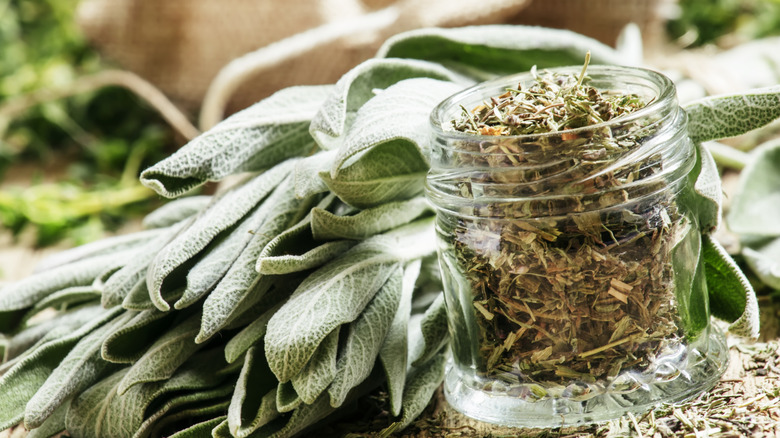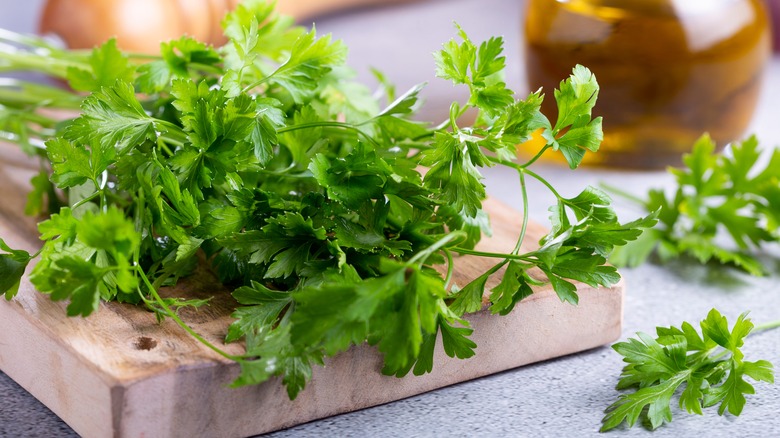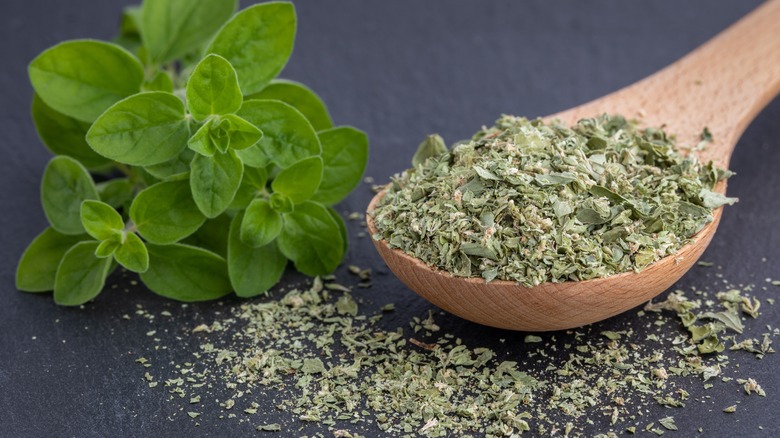The Cheat Sheet Conversion For Substituting Fresh Herbs And Dry Herbs
While the spice shelf might be deep with containers, some recipes call for fresh herbs. But if that fresh basil has wilted or the thyme has gone brown, dry herbs can be a viable substitute. Without complicated math calculations, the ratio equation is almost as simple as a dash or a pinch.
Although they may call herself a cook, not a chef, Rachael Ray has made cooking easier for many people. On their website, Rachael offers simple fresh herbs to dry herbs conversions. Her equation is that 1 tablespoon or "a scant palmful of fresh herbs" should replace 1 teaspoon of dried herbs. Since some cooks can replace the measuring spoon with a dash of this and a handful of that, the reference to a palmful is a helpful visual for many cooks. Although this equation may not reference inexact measurements for dried herbs, many recipes do not use sprinkles, dashes, or smattering to reference dried herb amounts.
The concept of converting fresh herbs to dry herbs is less about the precision of the conversion and more about the pungency of flavor. Dried herbs tend to have a more flavor consistency than fresh. Therefore, lesser amounts of dried ingredients are used in a dish. The next time the pantry is bare, or the garden has been harvested, a simple swap can save that recipe from being bland.
These delicate herbs are always better enjoyed fresh
While a simple equation that converts fresh and dried herb measurements can be handy, not every herb should be subject to that mathematical formula. Although fresh herbs, when purchased from a store, can be more expensive than dried, certain varieties should never be used dried because they lose their flavor when exposed to either too much heat or they lose their moisture. Some examples include chives, parsley, and tarragon.
Between dried and fresh parsley, dried parsley offers a less pungent flavor. While that hand from the spice rack might go unnoticed in a sauce, stew, or even soup, the fresh variety is not as subtle. Fresh parsley adds a pop of color and brings in a bright, almost zesty flavor. The difference between dried and fresh is noticeable, and cooks should use care when swapping the ingredients.
Chives are another example of an herb that is best enjoyed fresh. Once dehydrated or cooked, the herb loses a lot of its flavor. While dried herbs might be convenient, they are not always a perfect substitute. The recipe as a whole must be considered before just dumping ingredients into the pot.
These dried herbs hold their flavor better in recipes
On the flip side, some dried herbs can add nuance to a dish better than fresh variety. With dishes like stews, roasts, and even soups, dried herbs can infuse their flavor over time. Since fresh herbs lose their flavor pungency after about 10 minutes of cooking, the dried option elicits the same flavor and can be easier to incorporate. Some examples of dried herbs that are delightful in stovetop or longer cooking meals are oregano, thyme, bay leaf, and rosemary. As seen with this list, these herbs tend to be more sturdy, which lends themselves to holding up when dried.
Even though the dried herbs can release their flavor over time in a dish, these food items should not sit too long on the shelf. While grandma might have a container of oregano from 1988, the general rule of thumb is that dried herbs should be used within three years or sooner (via McCormick). Although herbs do not spoil like a dairy product or cause distress when eaten past their prime, they just become "not good."
If a dish lacks flavor even though the recipe was followed to the letter, it might be because the spices might have been sitting too long. It does not mean that a new jar should be purchased during every shopping trip. But, if the spice jar was purchased when no one had heard of a butter board, it might be time to clean out that cabinet.


